Long's Peak
| Longs Peak | |
|---|---|

Longs Peak seen from the east at sunrise.
|
|
| Highest point | |
| Elevation | 14,259 ft (4346 m) NAVD88 |
| Prominence | 2940 ft (896 m) |
| Isolation | 43.6 mi (70.2 km) |
| Listing | |
| Coordinates | 40°15′18″N 105°36′54″W / 40.2550135°N 105.6151153°WCoordinates: 40°15′18″N 105°36′54″W / 40.2550135°N 105.6151153°W |
| Geography | |
|
|
|
| Location |
High point of Rocky Mountain National Park and Boulder County, Colorado, U.S. |
| Parent range |
Front Range, Highest summit of the Twin Peaks Massif |
| Topo map |
USGS 7.5' topographic map Longs Peak, Colorado |
| Climbing | |
| First ascent | 1868 by John Wesley Powell and party |
| Easiest route | Keyhole (scramble) Class 3+ |
Longs Peak is a high and prominent mountain summit in the northern Front Range of the Rocky Mountains of North America. The 14,259-foot (4346 m) fourteener is located in the Rocky Mountain National Park Wilderness, 9.6 miles (15.5 km) southwest by south (bearing 209°) of the Town of Estes Park, Colorado, United States. Longs Peak is the northernmost fourteener in the Rocky Mountains and the highest point in Boulder County and Rocky Mountain National Park. The mountain was named in honor of explorer Stephen Harriman Long and is featured on the Colorado state quarter.
Longs Peak can be prominently seen from Longmont, Colorado, as well as from most of the northern Front Range Urban Corridor. Longs Peak is one of the most prominent mountains in Colorado, rising 9,000 feet (2,700 m) above the western edge of the Great Plains.
The peak is named for Major Stephen Long, who is said to be the first to spot the great mountains on behalf of the U.S. Government on June 30, 1820.
Together with the nearby Mount Meeker, the two are sometimes referred to as the Twin Peaks (not to be confused with a nearby lower mountain called Twin Sisters).
...
Wikipedia

